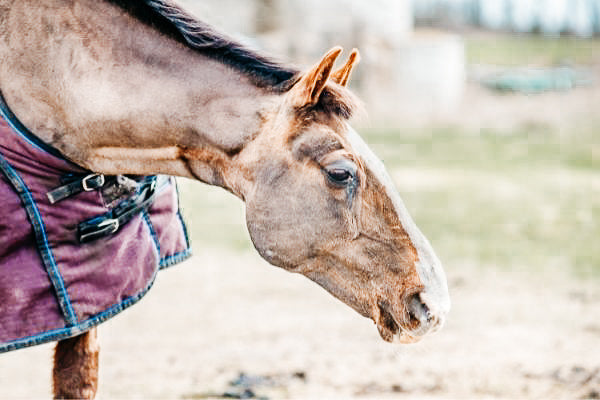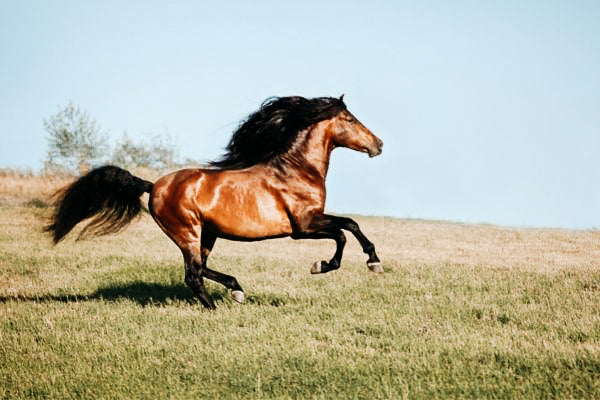
Throat blockage in horses – immediate help counts!
Many illnesses require quick action from the owner and veterinarian. Blockage of the throat is one of these emergencies and you should not wait here.
In fact, this condition is quite common and it is perfectly reasonable for you to worry about it. With good prior knowledge, you can even avoid horse disease on the one hand and, on the other hand, recognize its symptoms in an emergency so that you can then take the right measures as quickly as possible.
First aid can really save the horse's life!
What exactly is a blocked throat?
Definition: The animal's esophagus is partially or even completely blocked by one or more foreign bodies (usually food). So it mainly occurs during or shortly after feeding.
How can you recognize a blocked throat in a horse?
Typical symptoms:
- strong salivation (sometimes gushing)
- overextended neck and head posture (also downward extension)
- Neck area keeps contracting spasmodically
- Animal tries to get rid of the foreign body by coughing
- Backflow of leftover food from the nostrils
- it is possible that you can see or feel swelling on the neck
- increased or heavy breathing
- sweaty fur
- restlessness or nervousness
- possibly. Scratching
- the horse can panic
Depending on where exactly the blockage is in the esophagus, the first signs of symptoms appear. If the feed is placed just before the stomach, the animal will continue to eat until the tube is full of food. Only then does it react with profuse salivation.
If the blockage is above in the neck, the symptoms appear after a very short time.
What causes a blocked throat in horses?
The most common cause of this horse disease is hastily eaten food. Concentrated feed (pelleted), bread, chopped apples, carrots and beetroot and even small apples (whole) are usually greedily devoured. Even more noticeable when, for example, other people of the same species are in close proximity. Food envy often plays a role, as does improper feeding by passers-by over the fence.
Furthermore, the incorrect intake of feed is a big issue. If hay cobs and beet pulp are not soaked carefully before feeding, this can quickly have bad consequences. So be careful with sticky, floury or pressed feed! Many of them swell enormously and are a great danger to the four-legged friend. Short-stemmed hay is also not ideal and can cause problems.
In fact, there are still horses that can unfortunately develop a blockage in their esophagus due to illness. Behind this there is a narrowing of the throat or a so-called protuberance (recognizable e.g. b during an examination of the stomach in the horse clinic).
A dental problem (e.g. b when changing teeth or in old age) can lead to blockage of the horse's throat.
What can I do as the owner?
If you notice a horse's throat blockage, your first aid is important - contact your veterinarian or the nearby horse clinic immediately!
Because: If not treated promptly, injuries to the esophagus can result. The irritation inside is enormous. Saliva or food can also enter the airways, which can cause serious pneumonia. It's not nice when one horse disease replaces another. Therefore, first aid for the horse must be given immediately!
Important: Your horse is no longer allowed to consume food and water!
If your animal allows it, you can try to relieve the blockage by massaging the throat downwards (not towards the mouth!). If possible, stretch his head downwards. Do not move the animal unnecessarily and do not put your fingers in the horse's mouth (horses cannot vomit!)
If it reacts very nervously or even panicked, then don't put yourself in danger! It's better to wait until the vet arrives! He has the necessary sedatives at hand.
What does the vet or the horse clinic do?
When the veterinarian arrives, his first aid will immediately be a calming, antispasmodic medication that he will administer to the animal. The muscles can now relax. Minor blockages in the throat are already clearing up. If this is not the case, rinsing with water will help. The nasogastric tube is used here. This is pushed forward to the location of the piece of food in order to free it from it as quickly as possible.
Follow-up care for pharyngeal obstruction
If your first aid was able to help the horse quickly, it is important to relieve the irritated or injured esophagus. Usually only water is offered at the beginning and slowly over a few days you get back to normal feeding with mushy food (mash). Depending on the severity of the internal injury, pain-relieving medication may also be used.
To make sure that it is not due to dental problems, it is recommended to have your teeth checked quickly. It also makes sense to check your horse's temperature again and again over the next few days while he is resting (normal temperature 37.3 - 38.4 degrees). This means that a new horse illness (pneumonia) can be discovered quickly and treated immediately.
Preventive measures against pharyngeal obstruction in horses:
- Do not feed undissolved, dry beet pulp, wheat bran or hay beans. Always soak well!
- Apples, carrots etc. Do not chop them up, but do not feed them small apples in one piece
- If you are jealous of food, separate animals during feeding
- regular dental checks
- If you eat too quickly, put large stones in the trough and offer hay nets
- the pastures with a sign "Please do not feed!" equip
If you take these tips to heart, you can minimize the risk of a horse's throat blockage to a large extent.
Stay fit!
Discover more posts

6 basic tips for smart horse owners
If we are the proud owner of what we consider to be the most beautiful horse, then one thing quickly becomes clear to us. There is so much to regulate and do that daily riding becomes a hassle...
Continue reading
Andalusians – Iberian beauties with class
Iberian horses are considered the main ancestors of every horse breed, along with the Arabian and Berber. Their popularity is therefore increasing far beyond national borders. As a h...
Continue reading
